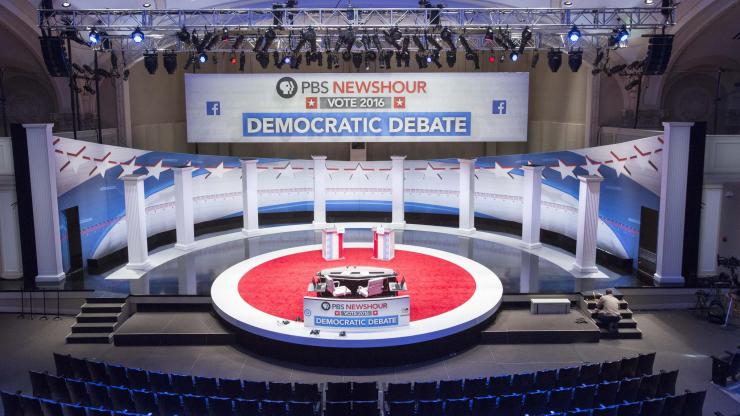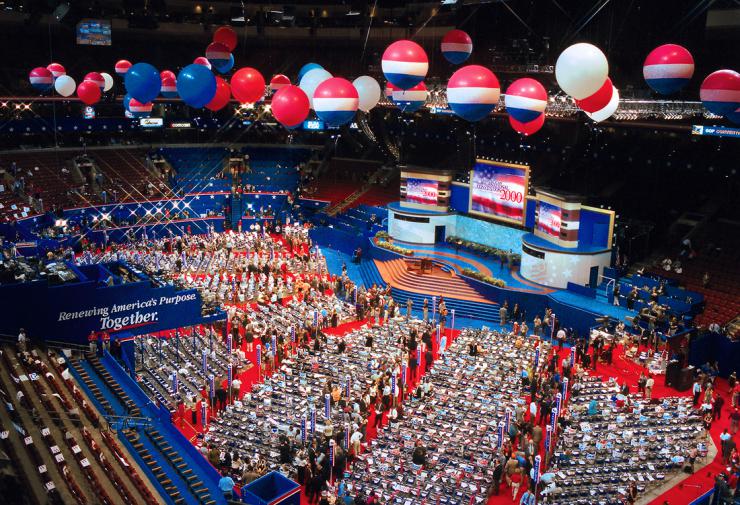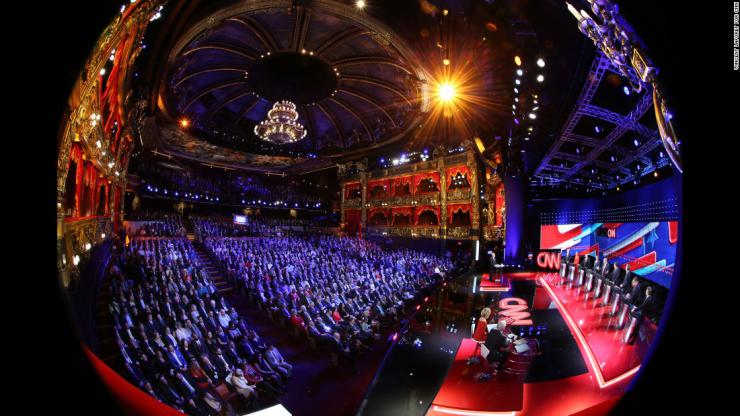Political Stage Design
I love politics. The stakes. The risks. The strategies. The drama of it all.
I’m a political junkie, but even if you’re not, I’m sure you’ve seen, heard, or read about the presidential race as it currently dominates social media and the news cycle. Trump’s latest bigoted, free word association and Bernie’s continued rise in the polls, along with endless articles about the “artful smear campaigns,” super PAC purchased attack ads, and the strangeness of politicians on display (or not—the stage manager couldn’t even get Ben Carson onstage) are being discussed around the world. Every few weeks this all culminates, before a live audience with millions of viewers at home as the candidates gather to debate issues facing the American people.

Over twenty-five million people tuned in to watch the first debate, making it one of the most watched political events ever. As Alan Schroeder discusses in his book Presidential Debates: Fifty Years of High-Risk TV, “Live televised debates teem with dramatic conflict: interpersonal conflict between candidates; interpersonal conflict within a debater’s psyche; the conflicts between expectations and performance, preparation and spontaneity. These juxtapositions make for irresistible TV, for conflict is the engine that propels all narrative, be it political, journalistic, dramatic or athletic.” It’s this narrative that drives everything.
These political events are pure drama. They’re an assembly of actors performing before an audience. It’s an environment where the stakes are real and anything could happen. It’s theatre.
These political events are pure drama. They’re an assembly of actors performing before an audience. It’s an environment where the stakes are real and anything could happen. It’s theatre.

In today’s political noise, visuals become the narrative, and as a scenic and media designer I couldn’t help looking at the stages and wondering, how do these events get designed? How does one decide what is presidential? And most importantly, how does Air Force One end up as a backdrop (if not a trophy) for eleven Republican nominees for President?
In 1960, John F. Kennedy and Richard Nixon took the stage for the first ever televised debate on CBS. As the story goes, Nixon declined makeup and proceeded to sweat under the hot studio lights. His team dressed him in a light grey suit that faded into the background and matched his skin tone. Kennedy, in contrast, glowed in a dark suit. His team recognized the storytelling power of television, so when it came Kennedy’s turn he spoke straight into the camera, directly into people’s homes, and would eventually go on to win the presidency. From that moment on the debates would be cemented as an American staple of the political process, and a marker of how vital design can be.
The goal of political design is to bring the political narrative to the people. As Sam Fiest, CNN’s Washington, DC bureau chief, explains, “You want people at home to really focus on what the candidates are saying.” Joe Lamberta, designer of this year’s Fox News debates for brand and event planning agency Jack Morton, describes, in conversation, the goal as “…creating a vehicle for the candidates to shape their opinions, in a way that it becomes a strong, but not distracting, scene.”
So where do you even begin?
The stages are designed for multi-camera set ups. Close-ups, wide shots, and side shots are all strategically used by the networks to frame the drama and reinforce conflict. In telling the debate narrative, the split screen has become a vital part in showcasing the differences between candidates when put in direct confrontation.

One of the biggest challenges is that, like doing live theatre, you have one chance. You rehearse, you prepare for everything, and still, there’s no guarantee that it’s all going to go according to plan.
“[Debates] are one of the rare opportunities you do get that crossover from just a news reporting show to a live event,” Lamberta explains. But crews are ready for anything because with an event like a debate or convention there is only one chance to get it right. Every possible situation is planned for. An extra podium was on standby in case Biden decided to run at the last minute. Lesli Tilly, a gaffer for The Lighting Design Group adds, “One of the biggest challenges—and also for me one of the joys—is that, like doing live theatre, you have one chance. You rehearse, you prepare for everything, and still, there’s no guarantee that it’s all going to go according to plan.” And most of the time, it doesn’t.
“We’ve been fortunate enough to work for Fox over the last three political cycles, so we’ve had some experience with what’s worked and what hasn’t. The main design inspiration or direction was based partially on what they would be utilizing in their graphics packages, because we wanted there to be a cohesiveness between not only what was built in three dimensions and seen around the candidates, but also when they cut to the graphics packages or the intros or the bump shots, that everything had a cohesive feel,” Mr. Lamberta asserted.
“One of the things that I noticed was there was a great amount of angular layered elements that worked really well together to create some depth and would be a great background for what they were trying to show as well.”
“I always felt that [the design] translated really well into political coverage because a lot of times you always are looking at some type of a bar graph or a line graph where you're seeing the comparisons between the various candidates.”

The spectacle of the storytelling takes focus as networks craft environments designed for high drama. Take for instance, the CNN Republican debate, designed by Clickspring Design, staged within The Phantom of the Opera theatre in Las Vegas (designed by Tony nominated set designer and architect David Rockwell) with its ever-flowing screens and operatic patriotism. It makes for great theatre (within a theatre).
But when you begin to fill the stage with up to eleven candidates, the stakes get higher and the whole event takes on a game show mentality. That’s a comparison that CNN isn’t afraid to shy away from. “… look how close we are to Air Force One right now. It's just amazing. The idea is that they want to be the commander-in-chief. They want the next Air Force One to be the one that they fly in.,” says Mark Preston, CNN editor of Politics. He’s referencing Reagan’s decommissioned Air Force One, a backdrop that required them build the stage up three stories, over a helicopter, just to get the shot. “Ronald Reagan is the patron saint of the modern Republican Party,” Sam Feist says. “It’s not just visually interesting, but I think as we talk about where the Republican Party is going…it’s also politically and editorially significant.”
When it comes to the design of the Fox News Debates, Lamberta says, “… if anything we were trying to figure out a way to make it less game show-like. I think that there is a level of dramatic design that’s brought in from all aspects, not just scenery, but we’ve got a phenomenal lighting designer in Dennis Size.” Part of the drama lies in the candidates themselves, whose performances set the tone on the stage.
“A winning debate strategy hinges in large measure on how well a candidate apprehends the experience as a televised drama. Smart debaters understand that their mission, at least in part, is to stage a performance for an audience—an audience that expects to be simultaneously enlightened and entertained. Debates demand theatricality, not to the exclusion of substance but in sufficient quantities to hold viewers attention.” Alan Schroeder says in his book. Donald Trump is the master of this. It’s a skill he has relied on and why every Republican debate descended into chaos and yelling.
What makes something presidential then? Is it the actor or the space that makes something feel and be presidential? Are these designs indicative of a party’s brand?
“I don't necessarily know if we're designing the Republican brand …” Lamberta responded,
… but I think that going into it we know that it's got to have a certain amount of gravitas because it is going to be referred to and it does reflect upon the Republican Party. [The design] has got to have just that strength to somewhat stand alone, but you also want it to have enough finesse where it's not distracting from what the actual show is, which is debating issues. That's one of the reasons we opted to stay away from moving imagery behind candidates. One of the earlier designs had some monitor elements built into certain areas of the walls, but we shied away from that and pulled away from that because we wanted the focus to be on the candidates and not really what was going on behind them.
From the networks point of view, I think there is also a different idea in what a president is and should be. Fox New’s debate stage is a more traditional and low-tech environment with its blue curtains and light box panels. In comparison, CNN’s debates are shiny, bold, packed with reflective surfaces and backed with an LED screen in constant motion. It’s slick and forward thinking. “I think there were a few different ways, obviously, that different networks addressed just the sheer amount of candidates for the Republicans,” Lamberta explains. “I think that, in the case with Fox … we wanted to create a set that would allow the versatility to have four people on it or twelve and not feel uncomfortable in either direction.
These differences in presentation also cross over between political parties. Take the February Democratic debate held in Wisconsin, with its arching back wall and columns that propel the candidates into an open forum discussion almost directly with the audience. The Democratic Party ideals of openness and welcoming are clearly showcased, creating an environment where actual ideas are debated and discussed, compared with the game show energy Donald Trump adds to the design.
At the end of the debate, I believe the storytelling nature of television shapes our view of the candidates and the event. Understanding this storytelling power becomes all the more important once a candidate is finally selected to represent his or her party.

Once the party’s conventions arrive, the goal of political design is to sell the candidate to viewers at home. Joe Stewart is a multi-Emmy award-winning production designer best known for Friends, Two and a Half Men, The Big Bang Theory, and The Ellen DeGeneres Show, among many others, and designed the 2000, 2004, and 2008 Republican Conventions. He is designing the upcoming Republican Convention this July but couldn’t speak to this year’s design.
The convention design “… goes back almost to Eisenhower… with the set, kind of the idea of a battleship,” Stewart explains. “It was conceptually the candidate at the convention itself, [steering the ship], and all of the delegates at the convention separated from the candidate. Sort of a big power position …” he notes. “That was a conceptual idea that both the Democrats and the Republicans employed.”
What happened with the first Bush convention [in 2000] was they did not want the candidate to appear imperial… what we did was marry the floor to the stage… so we had a color on the floor, then it would carry up the steps to a landing so we try to minimize the visual distance between the candidate and the delegates on the floor.
In an article for Wired Magazine, Jim Fenhagen, for Jack Morton, recalls “…designing the set for the 2012 RNC, when Mitt Romney was the party’s candidate. The RNC wanted to make Romney, who was then viewed as an elite East Coaster, feel more approachable and down to earth. The set became this concept of almost bringing you into his living room,” Fenhagen says. “The set, which jutted out into the audience to forge a closer connection with constituents, used wood tones to channel Frank Lloyd Wright’s warm, Midwestern aesthetic.”
In preparation of the biggest speech a candidate will ever give, how do you make the stage feel most presidential? “I think you know it when you see it. There are certain things to do with scale and certain things with the gravitas of the design that you know you can kind of get a feeling for it… It’s not beaded curtains yet.” Stewart joked.
There are no more Democrat or Republican debates planned and only a few months until the first convention. It’s shaping up to be a wild ride. But as you dissect the arguments each candidate makes, examine if the design supports the ideology and the gravitas of the candidate. Is the design supporting the idea of the highest office in the world or just turning everything into a show? In the end they’re all just actors on a stage that was designed for maximum impact. It’s all just theatre.










Comments
The article is just the start of the conversation—we want to know what you think about this subject, too! HowlRound is a space for knowledge-sharing, and we welcome spirited, thoughtful, and on-topic dialogue. Find our full comments policy here
Great piece, thanks.
Wow. I had never thought to analyze any part of the presidential debates beyond the faces that filled the screen. This article opened my eyes to the multiple ways that the audience is manipulated by those in charge of designing and producing the debate. The background of the debate is used as a means of shaping and reinforcing the larger themes and idea that the candidates want portrayed. But it does so subtly, so much so that most people do not realize they are being manipulated. Creating this beautiful marriage between design and narrative is easily applicable to theater. Just as the architecture and color scheme around the candidates spread a clear message, so does the set for a live theater piece. A good designer creates the physical world of the show, a component that is make-or-break in the immersion of the audience. I am still reeling at the similarities between the republican debate and a Broadway musical.
Great article ! Thank You.